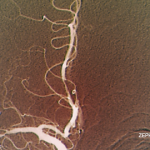An MRI of his brain revealed multiple snowball lesions within the corpus callosum, periventricular and subcortical white matter, as well as leptomeningeal enhancement. Audiometry showed bilateral sudden unilateral, sensorineural hearing loss and bilateral branch retinal artery occlusions.
Diagnosis
Both of these patients presented with acute onset encephalopathy, sudden unilateral, sensorineural hearing loss and bilateral branch retinal artery occlusions with MRIs revealing multiple lesions on the brain, including on the corpus callosum. This constellation of symptoms is consistent with Susac syndrome.
Clinical Courses
Patient 1 was treated with pulse-dose intravenous (IV) glucocorticoids followed by 60 mg of prednisone daily. She received induction IV cyclophosphamide and aspirin, demonstrating substantial improvement. After four months, she had no sign of active disease. She had some residual visual and hearing impairment but regained complete functionality. A repeat brain MRI showed chronic, inactive lesions. A slow glucocorticoid taper was started, and she was transitioned from cyclophosphamide to a maintenance dose of mycophenolate mofetil and aspirin for the next three years. At this time, immunosuppressive therapy was stopped, and she has remained in clinical remission.
Patient 2 was also treated with pulse-dose IV glucocorticoids, induction IV cyclophosphamide and aspirin, with improvement. However, he suffered a flare one month later, with new branch retinal artery occlusions and lesions found on a brain MRI. He was treated with repeat pulse-dose glucocorticoids, induction IV cyclophosphamide and the addition of intravenous immunoglobulin (IVIG). Two months later, his disease flared again, and he required a third round of pulse-dose glucocorticoids. Rituximab was added to the cyclophosphamide, IVIG and glucocorticoids—finally leading to clinical remission. A slow glucocorticoid taper was started, cyclophosphamide was transitioned to a maintenance dose of mycophenolate mofetil, and rituximab and IVIG were continued. IVIG was discontinued a few years later due to a severe adverse reaction.
Over the past few years, patient 2 has had recurrent episodes of visual disturbances, with evidence of vascular leakage on ophthalmologic exam. His hearing loss has remained stable and persistent and is managed with the support of hearing aids. He has no residual neurological or cognitive defects. Despite his medical challenges, he obtained his bachelor’s degree and now works as a software developer. He was recently married.
Despite similarities in clinical presentation, these patients had distinct clinical courses. Patient 1 had a favorable response to initial immunosuppressive therapy, ultimately leading to prolonged drug-free remission. Patient 2 suffered refractory disease with persistent episodes of visual disturbances, requiring ongoing aggressive immunosuppressive treatment.

